Jaskyna Domica
Domica Cave
Useful Information
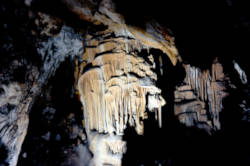
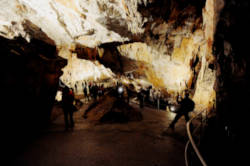
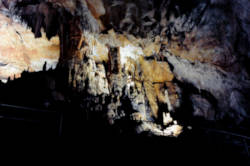
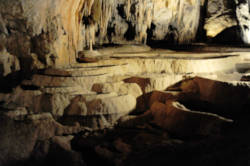
| Location: |
Jaskyňa Domica, 049 55 Dlhá Ves.
In the National Nature Reserve Domicke Karren. Slovensky kras, Silicka planina, cadastral area Kecovo, district Roznava, Kosicky region. (48.4777575, 20.4698154) |
| Open: |
FEB to MAY Tue-Sun 9:30, 11, 12:30, 14. JUN to AUG Tue-Sun 9-16, hourly on the full hour. SEP to NOV Tue-Sun 9:30, 11, 12:30, 14. Closed 26-SEP, 01-NOV. [2025] |
| Fee: |
Short Tour:
Adults EUR 10, Children (6-15) EUR 5, Students EUR 9, Disabled EUR 5, Seniors (60+) EUR 9. Foto Permit EUR 7. [2025] |
| Classification: |
 Karst Cave
light limestones of the Middle Triassic Age. Karst Cave
light limestones of the Middle Triassic Age.
 SWHL SWHL
 ISCA ISCA
|
| Light: |
 Incandescent Incandescent
|
| Dimension: | L=5,368 m, A=330 m asl, VR=70 m, T=10-11 °C, H=95-98 %. |
| Guided tours: |
Short Tour: L=780 m, D=45 min. With Boat Ride: L=930 m, D=60 min. Boat Ride: L=140 m. V=25,000/a [2000] |
| Photography: | allowed with permit and without tripod |
| Accessibility: | no |
| Bibliography: |
Robert Townson (1793):
Jaskyna Domica - A Journey Through Domica Cave in 1793
In: Travels in Hungary. A Journey Through Domica Cave in 1793, by Robert Townson A Journey Through Domica Cave in 1793, by Robert Townson
|
| Address: |
Jaskyna Domica, 049 55 Dlha Ves, Tel: +421 +942-7882010.
Správa slovenských jaskýň, Hodžova 11, 031 01 Liptovský Mikuláš, Tel: +421-44-553-61-01, Tel: +421-44-553-64-11. E-mail: |
| As far as we know this information was accurate when it was published (see years in brackets), but may have changed since then. Please check rates and details directly with the companies in question if you need more recent info. |
|
History
| 1801 | cave described by L. Bartolomeides. |
| 1926 | new parts discovered in the long known Old Domica Cave by Jan Maijko. |
| 1929 | connected to the Certova Diera Cave. |
| 1930 | opened to the public by the Club of Czechoslovak Tourists (KČST). |
| 1932 | Dr Herbert Kessler discovered the connection to Baradla Cave in Hungary. |
| 1932 | river Styx dammed up for the boat ride. |
| 1954 | cave flooded. |
| 1955 | cave flooded. |
| 1964 | cave flooded. |
| 1977 | cave flooded. |
| 1981 | cave flooded. |
| 1995 | inscribed on the UNESCO World Heritage List. |
Description
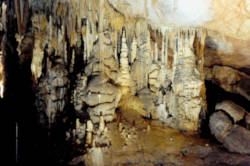
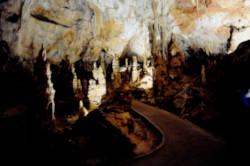
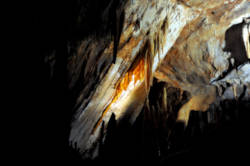

The beautiful Domica Cave is situated on the southern fringe of the Skalica plateau, at an altitude of 330 m asl.
It is not far from the town of Plesivec and quite close to the Hungarian border.
The Old Domica Cave has been long known but new passages were discovered by Jan Maijko in 1926.
In 1929, it was connected to the Certova Diera Cave and in 1932 Dr Herbert Kessler, whilst exploring
 Baradla-barlang Aggtelek lejárat
in Hungary, found the connection to Domica Cave, resulting in a system over 21 km in length, most of which is now open to the public.
However, the subterranean border between the two countries is securely protected by a substantial iron gate!
Baradla-barlang Aggtelek lejárat
in Hungary, found the connection to Domica Cave, resulting in a system over 21 km in length, most of which is now open to the public.
However, the subterranean border between the two countries is securely protected by a substantial iron gate!
Domica is a typical river cave with oval passages on three levels. The lower levels contain two rivers the Domica and the Styx. The latter river still flows through the cave and continues on into Hungary. The River Styx is also part of the tourist route. The river provides an experience which will make a lasting impression on the visitor, a memorable 140 m long boat ride. Catastrophic floods inundated the cave in June 1954. Other floods occurred in 1955, 1964, 1977 and 1981.
The middle level has been opened up to tourists since 1932. Wide concrete pathways weave in and out of the amazing speleothems: The Majko Dome with its sinter basins; The Japanese tea-house, an amazing chamber with stalactite columns, palettes and a stalagmite floor, supported by another range of stalactite columns; but the highlight of the cave has to be the Dome of the India Pagodas, a 20 m high chamber packet with enormous columns and beehive shaped formations.
The cave is a haven for both plant and animal life and is home to the largest colony in Slovakia of Rhinolophus euryale or the Horseshoe Bat. It is reputed to contain over 1000 bats. This is only one of 11 species of bat found in the cave.
Domica Cave is a site of great archaeological significance. Finds, including a fine flint arrrowhead, have been dated to the Old Stone Age or Szeletien Period, about 35,000 BC. Charcoal drawings found in the depths of the cave indicate some spiritual or ritual activities took place there. In the Neolithic or New Stone Age the cave was inhabited by early man. There have been rich finds from the Bükk (Bukovohorská) culture, about 6400 to 6100 BC, including pottery, bones and remnants of a circular building. The finds also included the many bones of the cave bear, Ursus spelaeus, suggesting that early man was not the only inhabitant of this cave, but the greatest find is a cooking pot covered in stalagmite, forever frozen in time.
This section of the Slovak / Hungarian border is one of the few areas where customs regulations have been relaxed and, after visiting Domica, it is possible to cross the border with the minimum of fuss and visit the
 Baradla-barlang Aggtelek lejárat
in Hungary.
Baradla-barlang Aggtelek lejárat
in Hungary.
Text by Tony Oldham (2002). With kind permission. Date of visit Sept 1973.
Above description is stille quite accurate, although it is from 1973 and thus more than 50 years old, but caves change only in geologic times. The political situation has changed though, and the Cold War is over, the two countries Hungaria and Slovakia are now part of the EU and Schengen, and obviously there is no underground border any more. The rusty remains of the iron curtain are a Historic Monument though. The standard visit is dubbed the "short tour", as there is also the "long tour", which is actually the same tour plus a boat ride. During the last years the water level was too low during summer for the boat ride, so the long tour is actually not offered any more, although it officially still exists.
 Search DuckDuckGo for "Domica Cave"
Search DuckDuckGo for "Domica Cave" Google Earth Placemark
Google Earth Placemark OpenStreetMap
OpenStreetMap Domica Cave - Wikipedia (visited: 05-JUL-2025)
Domica Cave - Wikipedia (visited: 05-JUL-2025) Domica Cave, official website (visited: 05-JUL-2025)
Domica Cave, official website (visited: 05-JUL-2025) Index
Index Topics
Topics Hierarchical
Hierarchical Countries
Countries Maps
Maps